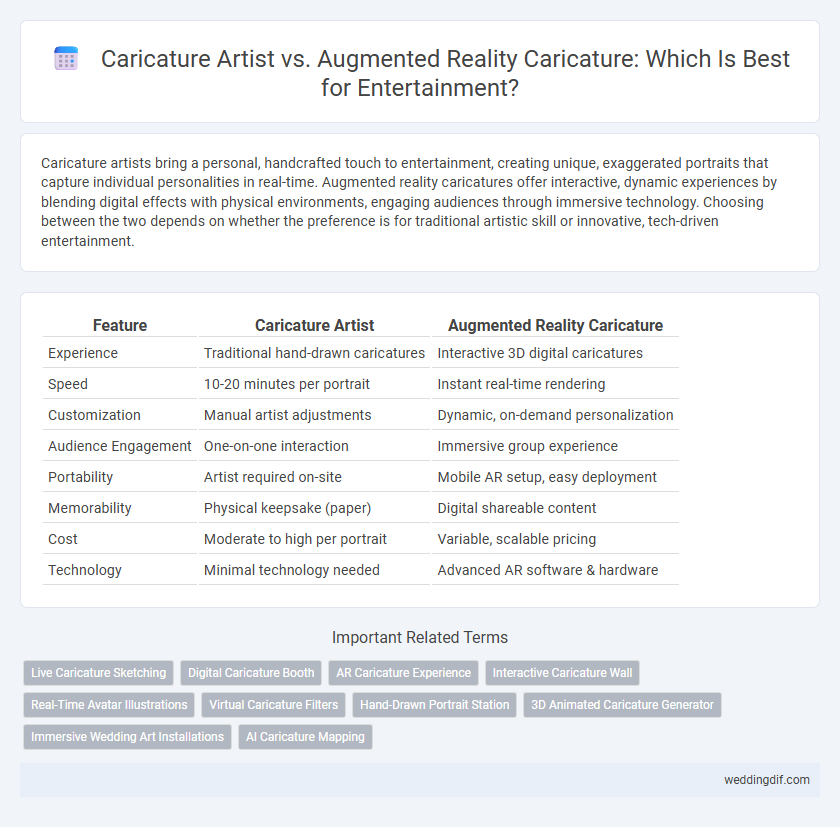Caricature artists bring a personal, handcrafted touch to entertainment, creating unique, exaggerated portraits that capture individual personalities in real-time. Augmented reality caricatures offer interactive, dynamic experiences by blending digital effects with physical environments, engaging audiences through immersive technology. Choosing between the two depends on whether the preference is for traditional artistic skill or innovative, tech-driven entertainment.
Table of Comparison
| Feature | Caricature Artist | Augmented Reality Caricature |
|---|---|---|
| Experience | Traditional hand-drawn caricatures | Interactive 3D digital caricatures |
| Speed | 10-20 minutes per portrait | Instant real-time rendering |
| Customization | Manual artist adjustments | Dynamic, on-demand personalization |
| Audience Engagement | One-on-one interaction | Immersive group experience |
| Portability | Artist required on-site | Mobile AR setup, easy deployment |
| Memorability | Physical keepsake (paper) | Digital shareable content |
| Cost | Moderate to high per portrait | Variable, scalable pricing |
| Technology | Minimal technology needed | Advanced AR software & hardware |
Introduction: Traditional vs. Augmented Reality Caricature Entertainment
Traditional caricature artists deliver personalized, hand-drawn portraits emphasizing exaggerated facial features to capture unique character traits, offering a tactile and memorable keepsake. Augmented reality caricature entertainment leverages advanced AR technology to create interactive, dynamic 3D caricatures in real-time, enhancing audience engagement through immersive digital experiences. Both methods cater to entertainment needs but differ significantly in execution, user interaction, and technological integration.
Unique Guest Experience: Live Artist Interaction vs. Digital Fun
A live caricature artist offers personalized, interactive entertainment by capturing guests' unique features with real-time sketches, creating memorable keepsakes. Augmented Reality (AR) caricatures provide dynamic, engaging digital experiences where guests can instantly see playful, animated versions of themselves on screens or devices. This contrast highlights the tactile charm and creative expression of traditional artistry versus the innovative, tech-driven fun of AR, catering to varied entertainment preferences at events.
Customization: Personalized Art vs. Immersive Filters
Caricature artists create highly customized, hand-drawn portraits that capture unique facial features and personality traits, offering a personalized art experience. In contrast, augmented reality caricatures use immersive filters to instantly alter facial characteristics digitally, providing an interactive but less individualized form of entertainment. The tactile craft of traditional caricatures appeals to those valuing bespoke artistry, while AR filters attract audiences seeking dynamic, shareable content.
Guest Engagement: Drawing Crowds vs. Virtual Appeal
Caricature artists attract crowds by offering personalized, hand-drawn portraits that create memorable, interactive experiences during events. Augmented reality caricatures enhance guest engagement by providing immersive, customizable digital avatars that guests can share instantly on social media platforms. Both methods increase entertainment value, with live artists fostering direct social interaction while AR technology appeals to tech-savvy audiences through innovative virtual experiences.
Artistic Style: Hand-Drawn Caricatures vs. Digital Renderings
Hand-drawn caricatures showcase unique artistic styles characterized by personal touch, intricate line work, and expressive facial features that capture individual personality with traditional media. Augmented reality caricatures utilize advanced digital renderings, offering dynamic, interactive visuals that blend real-time animation with user engagement. The contrast lies in the tangible artistry and emotional authenticity of hand-drawn pieces versus the immersive, technologically driven experience of AR caricatures.
Technology Requirements: Minimal Setup vs. High-Tech Necessities
Caricature artists require minimal setup, typically just paper, drawing tools, and a portable workstation, making them easily adaptable to various event settings. In contrast, augmented reality caricature entertainment demands high-tech necessities such as advanced cameras, powerful processors, and specialized software to create interactive digital avatars. The technological complexity of augmented reality setups often requires dedicated space and technical support, contrasting with the simplicity and mobility of traditional caricature artistry.
Keepsakes: Physical Artwork vs. Digital Souvenirs
Caricature artists create personalized, hand-drawn keepsakes that capture the unique essence of each subject, offering a tangible, one-of-a-kind souvenir. Augmented reality caricatures provide digital memorabilia that can be easily shared and stored, combining interactivity with modern technology. Both forms deliver memorable entertainment, but physical artwork offers a lasting emotional connection while digital souvenirs emphasize convenience and innovative engagement.
Venue Flexibility: On-Site Drawing vs. AR Anywhere
Traditional caricature artists offer personalized, on-site drawings that create a unique, interactive experience at venues such as parties, corporate events, and fairs, enhancing engagement through direct human interaction. Augmented Reality (AR) caricatures provide unmatched venue flexibility by allowing users to create and share digital caricatures anywhere, eliminating the need for physical presence and enabling remote participation. This AR technology leverages mobile devices and cloud platforms, expanding entertainment possibilities beyond geographic limitations and traditional event spaces.
Social Sharing: Paper Prints vs. Instant Digital Sharing
Traditional caricature artists create personalized paper prints that offer tangible keepsakes, often cherished for their artistic value and physical presence. Augmented reality caricature experiences enable instant digital sharing across social media platforms, amplifying visibility and engagement with interactive, shareable content. The digital format enhances viral potential and real-time audience interaction, contrasting with the limited distribution of paper prints.
Cost Comparison: Traditional Artist Fees vs. AR Service Pricing
Traditional caricature artists usually charge between $150 to $300 per hour, depending on experience and event type, with potential additional costs for materials and travel. Augmented Reality (AR) caricature services typically offer pricing models ranging from $200 to $500 for event packages, which may include digital setup, multiple user interactions, and instant social media sharing. While traditional fees cover personalized hand-drawn art, AR services provide scalable, interactive experiences that justify higher upfront costs but potentially lower per-user expenses at large events.
Caricature Artist vs Augmented Reality Caricature for entertainment. Infographic

 weddingdif.com
weddingdif.com